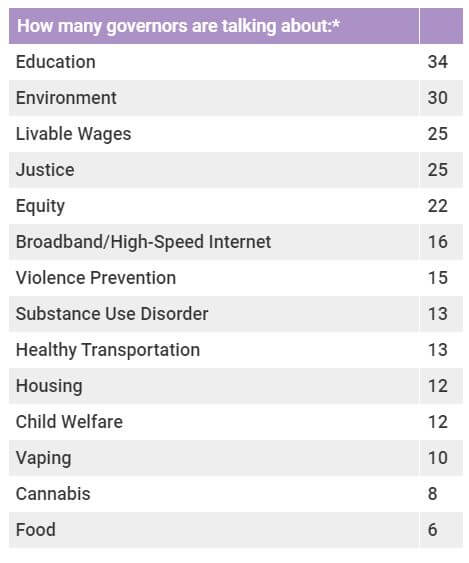State of the state speeches provide critical insights into governors’ policy proposals that impact the health of their residents. Last week, the National Academy for State Health Policy (NASHP) highlighted the health care issues governors raised in their 2020 addresses. This week, NASHP examines how governors addressed the social and economic issues that heavily impact health and well-being.

*These counts reflect governors’ state of the state speeches through Feb. 10, 2020.
View an interactive chart to discover how 39 governors addressed the social and economic issues impacting health.
As of Feb. 10, 2020, 39 governors had outlined health-related social and economic policy priorities – most commonly, education, the environment, and livable wages, followed by justice system reforms and social and health equity improvements.
Their other priorities included reducing violence, food insecurity, homelessness, maternal mortality, and human trafficking. Compared to the 2019 speeches, governors’ priorities have shifted in the last year – more addressed the need for environmental protection, justice system reform, and expanded access to broadband. Given that health is shaped by myriad conditions in which people live, work, and age, it is not surprising that many topics were interrelated and crossed sectors. For example, governors who mentioned plans to address education touched on both livable wages for school employees and violence prevention in schools.
Of the 34 governors who addressed education, many focused on early education and early literacy, student debt relief, and increased school resources. Here are some excerpts:
- New York Gov. Andrew Cuomo said: “Education is the civil rights issue of our time, and we should be proud that we invest more per student than any state in the nation. In our state, wealthier schools spend as much as $36,000 per student. In a poorer school, we spend as little as $13,000 per student. The progressive path is clear. Use our state funds to reduce the funding disparities. Our state funds are only 40 percent of the funding. Sixty percent of the funding comes from local taxes. … [Let’s] use state funds to raise those at the bottom. … Fund the poorer schools and close the education gap. And let’s do it this year.”
- Colorado Gov. Jared Polis said: “And in my budget this year, we’re proposing to help an additional 6,000 children attend preschool, which for the first time will bring coverage to half of all eligible kids in Colorado… And early childhood education isn’t just about giving our kids a great start in life. Every dollar invested in high-quality preschool produces a seven-dollar return on investment due to higher earnings, lower special education needs, greater tax revenues, less dependency on public assistance, and lower crime rates. This isn’t just the right thing to do, it’s the smart thing to do.”
Thirty governors addressed the connection between the environment and human health through environmental goals, such as increased production of renewable energy, preservation of natural resources, and decreased emissions:
- Florida Gov. Ron DeSantis commented: “[T]he comprehensive water quality legislation I have proposed . represents the initial recommendations of the Blue-Green Algae task force that I launched upon taking office. It is based on sound science and provides a roadmap to reduce nutrients in our water. – We at the state level will also be doing our part to fortify our infrastructure in our areas most vulnerable to increased flood risks. ‘ The bottom line is we have a chance to take bold action to make a lasting positive impact upon Florida’s environment. Let’s seize this opportunity.”
- Vermont Gov. Phil Scott said: “We’re committed to restoring and protecting our lakes and rivers, which will cost Vermonters nearly $1 billion over the next 20 years’. We rank high when it comes to air quality, but we can do more to lower emissions in our state, so I’ll propose using [Volkswagen] settlement funds to help more Vermonters purchase electric vehicles. And my budget will propose a long-term funding source for our water quality initiatives, using existing revenues and a new delivery model to put this money to work on the ground.”
Research suggests that generating livable wages by raising the minimum wage can help improve health and reduce infant mortality. Of the 25 governors who addressed livable wages, several mentioned raising teachers’ pay or raising the minimum wage:
- Connecticut Gov. Ned Lamont said: “We adopted America’s best $15 minimum wage law, which has already helped lift thousands of families out of poverty. Right now, working families have seen a $35 per week raise that lets them spend time with their child instead of picking up another work shift. In the next five years, that law will help more than half a million Connecticut workers – especially women and people of color – receive their fair share of a growing economy.”
- Georgia Gov. Brian Kemp explained: “In my budget, I have included a $2,000 pay raise for all public school educators. This raise will enhance retention rates, boost recruitment numbers, and improve educational outcomes in schools throughout Georgia. By investing in our educators, we can build a strong house, a place where everyone learns and all Georgians have the opportunity to thrive.”
Twenty-five governors highlighted plans to reform the criminal justice system and decrease recidivism through increased funding for re-entry programs, new job-match programs, and recovery services:
- Iowa Gov. Kim Reynolds explained: “I’ve made it a priority of this administration to focus on prisoner re-entry and rehabilitation, because our prisons shouldn’t be one stop in a circle that leads back to prison. Those in our correctional facilities are serving time for a reason, but when they leave, we want them to succeed. – I am renewing my support to amend our Constitution so that it no longer bars felons from voting after they’ve served their sentence.”
- Kentucky Gov. Andy Beshear said: “Successful criminal justice reform must do several things. It must reduce our incarcerated population. It must decrease recidivism and the revocation of probation and parole. It must address the racial bias and racism in our justice system. It must provide meaningful addiction treatment and recovery services. It must consolidate, and not expand our state prison institutions.”
Twenty-two governors mentioned the need for educational, economic, and social equity:
- Illinois Gov. J.B. Pritzker commented: “The input of women and people of color needs to be treated as essential to decision making – not as some token show of diversity. Bit by bit, inch by inch, I am working hard to reverse the harm that has been done to people and communities that have been left behind over many generations by government policies and elected officials who were content to simply ignore them. I remind myself every day that I have obligations not just to the current people of Illinois, but to the many people who preceded us who were discriminated against, harmed, treated as lesser, and forgotten – lasting damage that echoes through too many communities today. We are obligated to make our future more equitable and fair.”
- Michigan Gov. Gretchen Whitmer said: “And my administration is working to ensure a safe, healthy environment for all new moms, especially moms of color. This year, my budget proposal will extend health coverage for low-income women who have had babies. We will extend postpartum care from 60 days to one full year after giving birth, and move up a woman’s first postpartum visit to within three weeks, with a comprehensive visit within 12 weeks. This will help new moms heal, and work through postpartum depression and anxiety after giving birth.”
Sixteen governors addressed the need to expand broadband and high-speed internet services, especially in rural areas:
- Arizona Gov. Doug Ducey said: “Rural areas still lack high-speed Internet. Let’s triple our investment in Rural Broadband Grants, and also invest $50 million in Smart Highway Corridors to install broadband along our rural interstates. This will make our highways safer and smarter than ever before and pave the way to get all of rural Arizona logged on.”
- Idaho Gov. Brad Little commented: “I am also pursuing another strategic investment – improvements in Idaho’s broadband infrastructure. For both urban and rural Idaho to attract business and enhance our citizens’ quality of life, Idaho must be connected. I am adopting a recommendation from my Broadband Task Force – to establish a State Broadband Office. We will utilize existing resources at Commerce and unite the efforts taking place across the state to ensure all areas of Idaho are connected. Improving broadband will also expand tele-health and pharmacy access in rural Idaho, where the distance to a doctor or pharmacy can be overly burdensome to entire communities of people.”
Fifteen governors proposed strategies for preventing violence and suicide in their state:
- Rhode Island Gov. Gina Raimondo explained: “Protecting our future means protecting our neighborhoods, workplaces, and schools from gun violence. Even one tragedy with an untraceable, homemade firearm is one too many. Loopholes that allow extremely dangerous people to get guns need to be closed. Military-style assault weapons don’t belong in our communities and should be banned. So this year, I will once again propose a comprehensive package of gun reforms.”
- Wyoming Gov. Mark Gordon said: “One area of focus is on the prevention of suicide. This issue struck close to home when I heard from classmates of my own kids who have struggled with these dark thoughts. Too many of our residents are suffering – and sadly, far too many are acting on it. I have supported funding to launch an in-state suicide hotline. This is just a start. We need to work with providers and leverage all of our state resources to do a better job of attending to those in need.”
NASHP will continue to track these trends along with proposals and other legislative and executive action on social and economic issues that have clear implications for health.
*This analysis includes information from state of the state speeches, and not from inaugural presentations or budget addresses.


